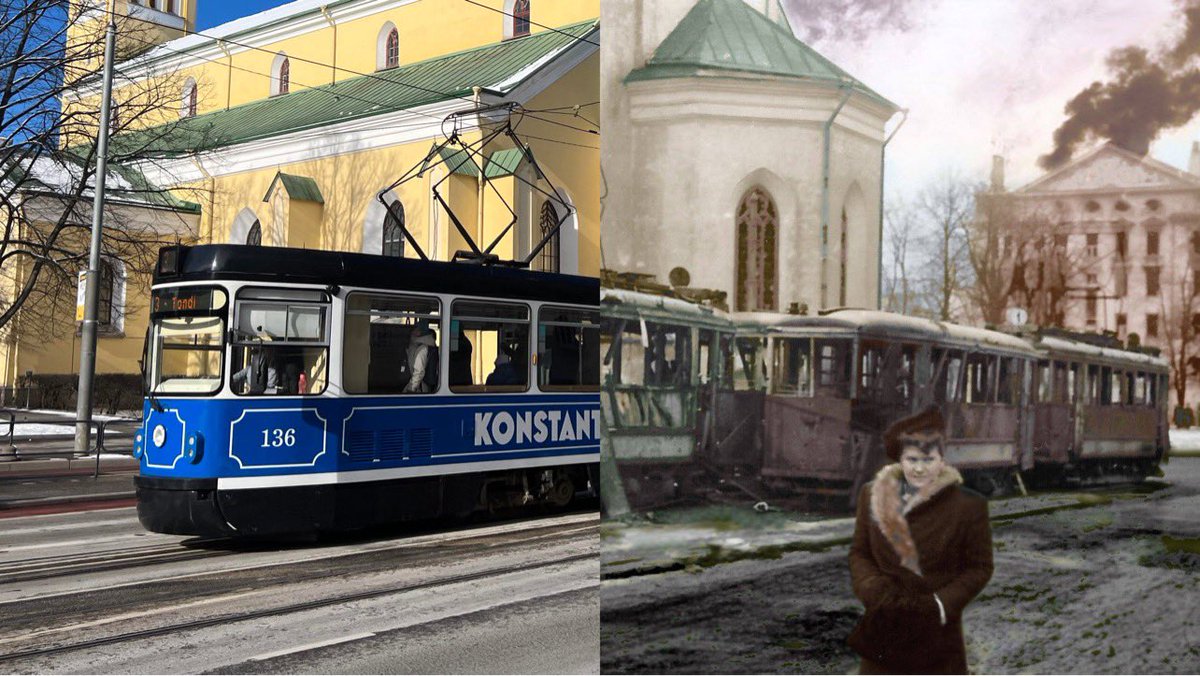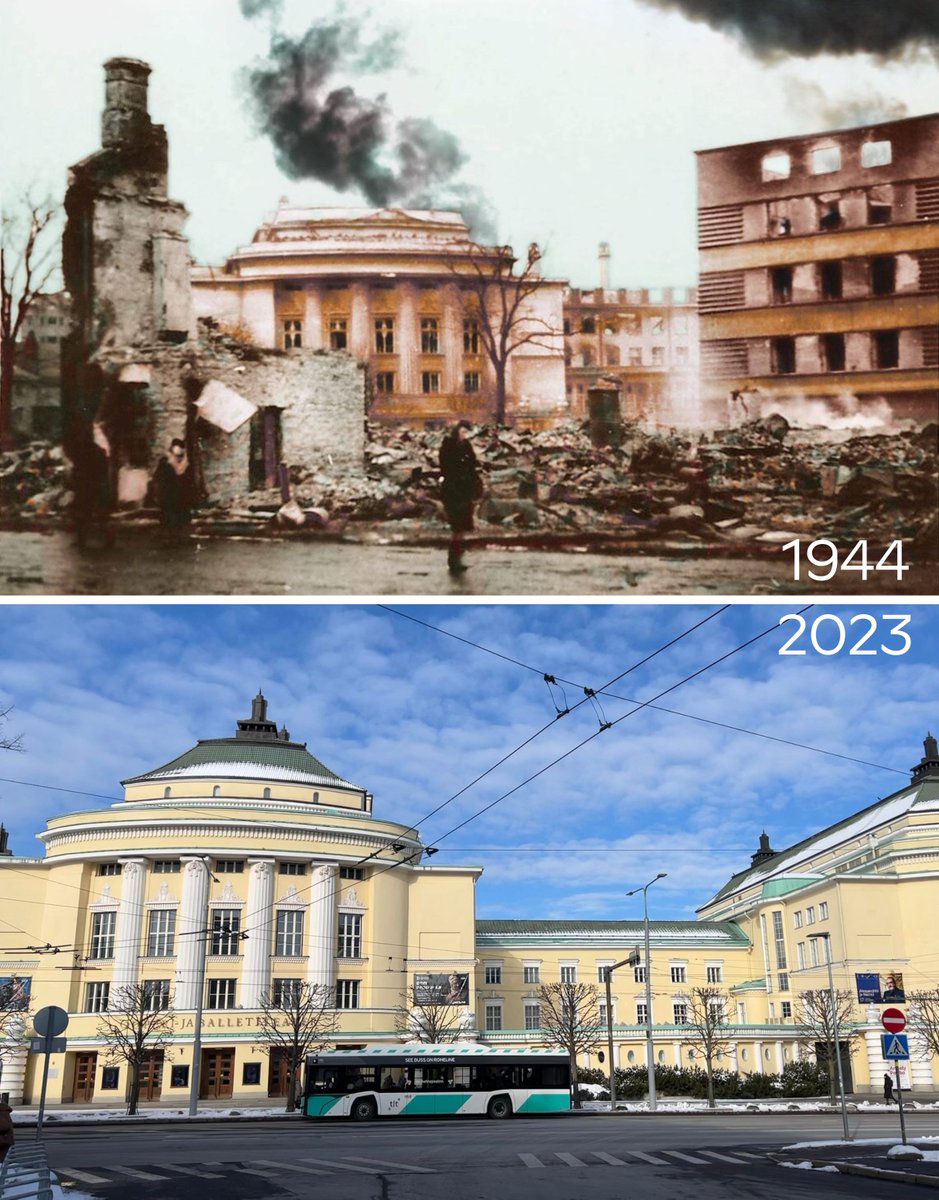79 years ago today, Tallinn was devastated by Soviet bombs that primarily & deliberately targeted homes & cultural landmarks.
Let’s talk about what happened (with then & now pics) …and why it strengthened Estonia’s determination to rebuild its independent nation. 🧵 https://t.co/5cBhucCQnD

If you visit Tallinn today, the scale of the devastation is difficult to imagine while strolling the mostly postcard-perfect Old Town.
But take a look below your feet. Those seemingly odd pavement patterns are actually where buildings stood until 9 March 1944. https://t.co/dtDkIxF52S

Around a quarter of Tallinn was destroyed, almost overnight. Up to 300 Red Army aircraft were involved and their primary targets were residential districts, as well as cultural landmarks, including the national theatre, a church and a synagogue, hospitals, cinemas and hotels. https://t.co/R404bsd0ZE

Flares were dropped first to ensure these targets were clearly visible to bombers. To ensure maximum devastation, Soviet saboteurs on the ground had already snuck in early to blow up the water pumping stations needed by fire brigades. https://t.co/5TLCdPd3v2

More than 600 civilians were killed, around the same number were injured, more than 20,000 became instantly homeless – and a mass exodus from the country to escape further attacks would begin.
The Estonia Theatre was a key symbol of Estonian culture and where the first Estonian parliament had convened after the country declared independence in 1918. It was utterly destroyed. https://t.co/JfZxTGlvVh

As the attack began, the first Estonian ballet, “Kratt” – based on old Estonian mythology – was on stage. Actors run out into the street, still in their devilish costumes while the city burned around them. The spectacle would be seared into Estonia’s collective memory. https://t.co/28j9jLUgsk

Bombs also hit the iconic St. Nicholas’ Church, obliterating almost everything inside, including its ornate pews, pulpit, balconies and epitaphs. https://t.co/nNXXjfAhSi

The tragedy really began in August 1939 when Nazi Germany and the Soviet Union together signed what they called their “non-aggression pact”. Yet it contained a secret protocol to aggressively tear up international law and divide sovereign European nations between them, beginning… https://twitter.com/i/web/status/1633713475590422529
The Estonian town of Narva was the first to face mass Soviet bombings in February. The entirety of the town was near totally destroyed.
After the Nazi retreat, Estonians raised their own flag once again and re-affirmed their independence in the hope that the world war would eventually end with the restoration of all pre-war territorial integrity. However, the Soviets continued bombing. https://t.co/wdEadioClq

The advancing Soviets tore down flags of Estonia and would continue their brutal occupation of the Baltic countries – as originally agreed with the Nazis – for nearly half a century more, unleashing more repression against civilians, including scaling up its mass deportations. https://t.co/OykG84XLvV

While the Soviets initially dropped leaflets after their bombs to justify the destruction, they fell immediately silent on the topic after their own occupation resumed.
Any talk of the bombings was heavily censored. Even the dead weren’t left to rest. At Liiva cemetery, the… https://twitter.com/i/web/status/1633714555057471488
Below, a woman in 1944 stands amid ruins looking up the street at what was left of St. Nicholas’ Church. Behind her are the ruins of houses, which would be left empty for decades until that spot was rebuilt as the Estonian Writer’s Union, which would also serve as a home to… https://twitter.com/i/web/status/1633714913913761792 https://t.co/4UUjS4vfpW

Kross focused on themes of state censorship and repression. On the surface, his stories often focused on the historical relationship between Estonians and their feudal overlords, but Estonians knew that it could also be read as a critique of ongoing historical oppression, such as… https://twitter.com/i/web/status/1633715180080095234 https://t.co/dRYVoVZKg2

Mythologies grew up around the March bombings, mostly centred on the Estonia Theatre. When it was rebuilt, trees were planted around it, and the people of Tallinn began to whisper that when the trees would reach full life then Estonia would be liberated from Soviet occupation.
One aspect of the tragedy was unknown to Estonians at the time of the bombings, however. While Estonians opposed both Soviet and Nazi occupations, the fact that both powers had originally colluded together to agree the Soviet occupation was kept hidden for decades. After the… https://twitter.com/i/web/status/1633715788317065216 https://t.co/Z3ibFGMjiq

The same tactics are failing today in Ukraine where civilian bombings – and even the return of mass deportations – have strengthened Ukraine’s determination to resist as a unified independent nation. As Estonia has shown, that sentiment won’t diminish even generations later.
Tallinn is illuminated with fire again every 9 March as night falls, but the flames these days are from hundreds of candles placed where buildings once stood and families once lived, ensuring they will never be forgotten. https://t.co/xQFGG9GmEU

